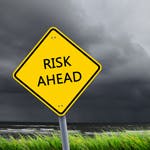In the first of the Small Business Success Professional Indemnity series GIO presents installment one: Risk Management: Protection of Small Business Enterprise.
The role of an SMB business owner is wide-ranging and understated: CEO, general manager, accountant, human resources manager, and marketer. Without the luxuries afforded to a larger organisation – such as having a risk management team – small business owners need to self-manage all risk scenarios and shortcomings in-house.
How they choose to navigate risk can be categorised using the AASR framework:
1. Accepting risk – recognising and living with the scenario of risk, or ‘gambling’; such as no insurance;
2. Avoiding risk – simply not undertaking risky aspects of a business;
3. Sharing risk – recognising risk but choosing to financially mitigate possible outcomes; such as investing in comprehensive business insurance; and
4. Reducing risk – putting procedures in place to reduce risk; such as installing safety signs in a hazard area.
Chris Stallard, senior leader for the SME Porfolio for GIO Insurance, recently spoke with financial expert Peter Switzer (Switzer TV) about small business risk management and how owners can manage the level of risk in their organisation. The emphasis that he places on knowing what a risk is, relates back to recognising any potential negative factor which can ultimately cost the livelihood of the business.
What is risk management?
From the perspective of insurance, effective risk management is identifying and assessing what could potentially be a harmful situation to the company and its employees from either an internal or external risk. It is identified by Business Victoria as relating to the compliance, employee, environmental, financial, health and safety, operational, political and economic, and strategic aspects of a business. Stallard identifies a risk management acronym (AIMD) that can be used by business owners to identify and evaluate their risk environment.
ASSESS – Build a picture of the environment by creating a comprehensive view of the business operations
INVESTIGATE – Where are the risks? When could they happen and who would it affect?
MITIGATE – Using the AASR framework to decide upon which avenue of navigation will be used e.g. relaying findings to an insurer who can assist with policies to align with identified risks, such as public liability insurance.
DOCUMENT – Compile and date all findings into a document for themselves and which could be used as legal documentation for WorkSafe Victoria.
Why do business owners need to be vigilant on risk?
Chris Stallard from GIO discusses the vigilance of risk within a business: “When you accept that you are the person responsible for risk management in your business, you become more alert and aware of possible problems. Knowing that you can solve most of these problems by transferring the risk to another party – your business insurance company – can change the way you think and act about insurance.”
A risk within a workplace could present itself in the form of an injury incurred by an employee as a result of lifting a heavy piece of equipment, or as a case of defamation against the company through social media. However, the seriousness and type of the incident could be avoided if the right risk management guidelines are in place to ensure that the livelihood and personnel of the company is protected. For example, most businesses protect themselves with staff contract clauses and social media guidelines to ensure that the company name and intellectual property is not compromised across social media channels.
The Victorian Department of Justice’s eGovernment Resource Centre provides free advice on social media guidelines for departmental employers, employees and external contractors using channels such as Facebook and Twitter. In the example of protecting staff against injury, WorkSafe Victoria can provide organisations with free advice on manual handling and how to navigate risk within small business through a five-step online guide.
Choosing the right cover
Small-to-medium business owners need to be mindful that one insurance policy may not cover all of their identified risks – a Fire or Theft policy will not provide cover for missed income during the period that a business is being renovated following fire damage; however an owner would be covered under Business Interruption Insurance.
“Businesses tend to not view their assets as the only items that need to be replaced after an event. In many instances businesses have collapsed when unable to replace revenue through insurance protection. This meant that overheads including rent and wages, could not be met,” Mr Stallard comments.
GIO recommends that business owners start with an alternative resource such as the WorkSafe Victoria’s Hazard Identification, Risk Assessment & Risk Control in the Workplace for Risk Management guidelines.

